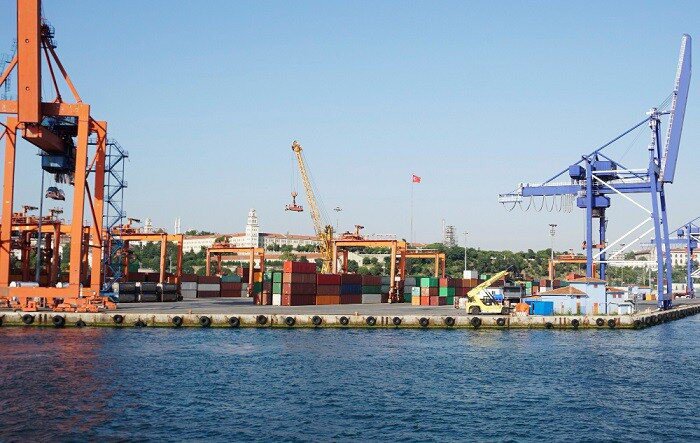
Shipping and logistics can be challenging for anyone involved in international trade. Have you ever wondered which ports around the world are best equipped to handle the massive volumes of cargo that pass through them daily? Understanding the efficiency and capacity of these ports is crucial for effective logistics planning and management. The largest ports in the world play a significant role in ensuring the smooth operation of global trade.
Shanghai Port is the largest port in the world, boasting an incredible capacity of over 47 million TEUs. It stands as a vital hub in global maritime trade, connecting numerous international shipping routes and supporting the flow of goods between continents.
This blog post will explore these leading global ports, shedding light on their importance in international trade. By gaining insights into these major ports, you can better understand their critical role in supporting economic development and fostering international relations.
Largest Ports in the World
1. Shanghai Port (China)
Shanghai Port is the biggest port in the world, handling over 47 million TEUs annually. Located at the mouth of the Yangtze River, it serves as a major hub for global maritime trade. Being the largest port in the world, this port boasts extensive facilities, including multiple container terminals and deep-water berths, capable of accommodating the largest container ships. Its strategic location makes it a critical gateway for both regional and international trade routes.
Key Features:
-
Handling Capacity: Over 47 million TEUs
-
Strategic Location: Mouth of the Yangtze River
-
Advanced Infrastructure: Automated terminals, deep-water berths
Economic Impact: As the biggest port in the world, Shanghai Port drives China’s economy by facilitating extensive international trade and supporting a broad network of industries and services.
2. Singapore Port (Singapore)
Singapore Port is known for its efficiency and strategic location, making it the second largest port in the world. With a handling capacity of approximately 37 million TEUs annually, it is a key transshipment hub connecting major shipping routes across Asia and beyond. The port’s advanced infrastructure includes high-tech cargo handling systems and a well-integrated logistics network.
Key Features:
-
Handling Capacity: Around 37 million TEUs
-
Strategic Location: Central position in Southeast Asia
-
Advanced Infrastructure: High-tech cargo handling systems
Economic Impact: The port is integral to Singapore’s economy, reinforcing its status as a leading global trade and logistics center and boosting regional and international trade activities.
3. Ningbo-Zhoushan Port (China)
Ningbo-Zhoushan Port is the third largest port in the world, with an annual handling capacity of approximately 30 million TEUs. Located in Zhejiang Province, this port benefits from its proximity to major manufacturing regions and serves as a key gateway for exports and imports. The port features modern container terminals and extensive warehousing capabilities.
Key Features:
-
Handling Capacity: Approximately 30 million TEUs
-
Strategic Location: Zhejiang Province
-
Advanced Infrastructure: Modern container terminals, extensive warehousing
Economic Impact: The port is vital for China’s export-driven economy, significantly impacting regional industrial activities and international trade networks.
4. Hong Kong Port (Hong Kong)
Hong Kong Port, one of the biggest ports in the world, handles around 20 million TEUs annually. Its strategic location along major maritime routes and its highly developed port infrastructure make it a central hub for trade in Asia. The port features advanced cargo handling systems and significant connectivity to global trade networks.
Key Features:
-
Handling Capacity: About 20 million TEUs
-
Strategic Location: South China Sea
-
Advanced Infrastructure: Efficient cargo handling and logistics
Economic Impact: Hong Kong Port supports the territory’s role as a global financial and trade center, contributing to its robust economy through extensive trade operations.
5. Busan Port (South Korea)
Busan Port is South Korea’s largest port and one of the biggest ports in the world, with a handling capacity of approximately 21 million TEUs annually. Located on the southeastern coast of South Korea, it serves as a major hub for both domestic and international trade. The port’s infrastructure includes modern container terminals and advanced cargo handling facilities.
Key Features:
-
Handling Capacity: Around 21 million TEUs
-
Strategic Location: South Korea’s southeastern coast
-
Advanced Infrastructure: Modern port facilities, logistics support
Economic Impact: The port is crucial to South Korea’s economy, supporting extensive export activities and contributing to the country’s industrial and commercial growth.
6. Port of Guangzhou (China)
The Port of Guangzhou is a major port in southern China, ranking among the biggest ports in the world with an annual capacity of about 18 million TEUs. Located on the Pearl River, it serves as a critical point for trade within China and with international markets. The port features modern infrastructure and efficient cargo handling systems.
Key Features:
-
Handling Capacity: Approximately 18 million TEUs
-
Strategic Location: Southern China
-
Advanced Infrastructure: Comprehensive cargo handling facilities
Economic Impact: The port plays a vital role in Guangzhou’s economic development, supporting regional trade and industrial activities.
7. Port of Shenzhen (China)
Port of Shenzhen, one of the biggest ports in the world, handles around 15 million TEUs annually. It is located close to Hong Kong and serves as a major gateway for trade in the region. The port’s advanced infrastructure and extensive facilities support its high cargo throughput and efficient operations.
Key Features:
-
Handling Capacity: About 15 million TEUs
-
Strategic Location: Southern China, near Hong Kong
-
Advanced Infrastructure: Modern facilities and technology
Economic Impact: The port is crucial for Shenzhen’s rapid economic growth, supporting its role as a major manufacturing and export center.
8. Port of Antwerp (Belgium)
Port of Antwerp, Europe’s second-largest port and one of the biggest ports in the world, handles around 12 million TEUs annually. Situated on the Scheldt River, it is a key gateway for trade in Europe. The port’s extensive facilities and advanced infrastructure, including a vast network of logistics and distribution centers, make it a central hub for European trade.
Key Features:
-
Handling Capacity: Approximately 12 million TEUs
-
Strategic Location: Belgium, on the North Sea coast
-
Advanced Infrastructure: Extensive cargo handling and logistics systems
Economic Impact: The port is vital for Belgium’s economy and European trade, supporting a broad range of industries and contributing significantly to regional economic growth.
9. Port of Rotterdam (Netherlands)
Port of Rotterdam is Europe’s largest port and one of the biggest ports in the world, with an annual handling capacity of around 14 million TEUs. Located on the North Sea, it serves as a major entry and exit point for goods moving in and out of Europe. The port features cutting-edge facilities and a comprehensive logistics network that supports its significant trade volume.
Key Features:
-
Handling Capacity: About 14 million TEUs
-
Strategic Location: Netherlands, on the North Sea
-
Advanced Infrastructure: World-class facilities and logistics networks
Economic Impact: The port is essential for Europe’s trade, facilitating economic activities across the continent and supporting numerous industries.
10. Port of Los Angeles (USA)
Port of Los Angeles is the largest port in the United States and one of the biggest ports in the world, handling around 10 million TEUs annually. Located in Southern California, it is a major gateway for goods entering North America. The port’s infrastructure includes state-of-the-art facilities and extensive logistics networks, making it a critical hub for US trade.
Key Features:
-
Handling Capacity: About 10 million TEUs
-
Strategic Location: Southern California, near major US cities
-
Advanced Infrastructure: State-of-the-art facilities and logistics support
Economic Impact: The port significantly impacts the US economy by supporting trade activities and industrial growth on the West Coast.
11. Port of Long Beach (USA)
Port of Long Beach is a major port on the West Coast of the United States and one of the biggest ports in the world, handling around 9 million TEUs annually. It is closely linked to the Port of Los Angeles and serves as a critical entry point for goods into North America. The port’s modern infrastructure and efficient operations support its substantial cargo volume.
Key Features:
-
Handling Capacity: Approximately 9 million TEUs
-
Strategic Location: Southern California
-
Advanced Infrastructure: Modern cargo handling and technology
Economic Impact: The port supports significant trade and industrial activities, contributing to the regional and national economy.
12. Port of Jebel Ali (UAE)
The Port of Jebel Ali is the largest port in the Middle East and one of the biggest ports in the world, with an annual handling capacity of around 14 million TEUs. Located in Dubai, it is a key hub for trade in the region. The port features extensive facilities and advanced technology, supporting its high cargo throughput.
Key Features:
-
Handling Capacity: About 14 million TEUs
-
Strategic Location: United Arab Emirates, on the Persian Gulf
-
Advanced Infrastructure: Extensive facilities and logistics networks
Economic Impact: The port is crucial for the UAE’s economy, driving regional trade and supporting industrial and commercial activities.
13. Port of Tanjung Priok (Indonesia)
Port of Tanjung Priok is Indonesia’s largest port and one of the biggest ports in the world, handling around 7 million TEUs annually. Located in Jakarta, it is a key gateway for trade in Southeast Asia. The port’s modern infrastructure and efficient operations support its significant role in regional trade.
Key Features:
-
Handling Capacity: Approximately 7 million TEUs
-
Strategic Location: Jakarta, Indonesia
-
Advanced Infrastructure: Modern cargo handling and logistics support
Economic Impact: The port plays a vital role in Indonesia’s economy, facilitating trade and supporting industrial activities.
14. Port of Hamburg (Germany)
The Port of Hamburg is Germany’s largest port and one of the biggest ports in the world, with an annual handling capacity of around 9 million TEUs. Located on the River Elbe, it serves as a major gateway for trade between Europe and the rest of the world. The port is well-known for its advanced infrastructure, including automated container terminals and efficient logistics networks that support high-volume cargo operations.
Key Features:
-
Handling Capacity: About 9 million TEUs
-
Strategic Location: Located on the River Elbe, near the North Sea
-
Advanced Infrastructure: Automated container terminals and efficient logistics systems
Economic Impact: The port is a crucial contributor to Germany’s economy, facilitating international trade, supporting industrial activities, and creating jobs across various sectors.
15. Port of Colombo (Sri Lanka)
Port of Colombo is Sri Lanka’s largest port and one of the biggest ports in the world, handling around 6 million TEUs annually. Located on the Indian Ocean, it serves as a critical hub for trade in South Asia. The port features modern facilities and extensive connectivity to regional and international trade routes.
Key Features:
-
Handling Capacity: Approximately 6 million TEUs
-
Strategic Location: Sri Lanka, on the Indian Ocean
-
Advanced Infrastructure: Modern facilities and connectivity
Economic Impact: The port is essential for Sri Lanka’s economy, supporting regional trade and contributing to industrial development.
These ports are integral to the global trade network, each playing a significant role in facilitating international commerce through their vast capacities, strategic locations, and advanced infrastructures. As the biggest ports in the world, they are crucial nodes in the smooth operation of global trade.
Key Features of the Biggest Ports in the World
- Massive Handling Capacities: The largest port in the world, like Shanghai Port, handle tens of millions of TEUs annually, making them essential hubs for global trade.
- Strategic Locations: These ports are typically located at key geographical points, such as the mouth of major rivers or along critical maritime routes, ensuring optimal access to international markets.
- Advanced Infrastructure: Equipped with cutting-edge technology, including automated container terminals, deep-water berths, and efficient cargo handling systems, these ports can manage large volumes of goods with speed and precision.
- Extensive Connectivity: The biggest ports connect with hundreds of other ports worldwide, forming an intricate network that supports the smooth flow of international trade.
- Economic Influence: These ports are not just transit points—they are economic powerhouses that drive the economies of their respective regions by facilitating imports, exports, and industrial growth.
- Sustainability Initiatives: Many of the world’s largest ports are leading the way in green practices, implementing measures to reduce carbon emissions and adopt eco-friendly technologies.
These features ensure that the biggest ports are indispensable to the global supply chain, playing a critical role in maintaining the flow of goods across the world.
Economic Impact of the Biggest Ports in the World
Global Trade Powerhouses
The biggest port in the world, such as Shanghai Port, are central to the global trade system, handling a significant portion of the world’s cargo. This sheer volume of trade supports economies far beyond their own borders, facilitating the exchange of goods on a massive scale.
Job Creation
These ports are major employers, directly and indirectly supporting millions of jobs. From dockworkers and logistics professionals to those in associated industries like transportation, warehousing, and manufacturing, the economic impact extends deep into the labor market.
Revenue Generation
The biggest ports generate substantial revenue for their respective regions through port fees, tariffs, and associated business activities. This revenue is reinvested into the local and national economies, supporting infrastructure development, public services, and further economic growth.
Industrial Development
Ports often attract businesses that rely on global supply chains, such as manufacturing plants, distribution centers, and export-oriented industries. The proximity to a major port can lower transportation costs and provide easier access to international markets, encouraging industrial growth.
Boosting Exports and Imports
By efficiently handling large volumes of cargo, the largest ports facilitate the export of goods, helping local industries reach global markets. They also support the import of essential goods, from raw materials to consumer products, which are vital for economic stability and growth.
Driving Regional and National Economies
The economic influence of these ports extends to the national level, where they play a crucial role in GDP growth. Countries with major ports often see enhanced economic performance due to the increased trade activity these hubs enable.
Innovation and Investment
The biggest ports are often at the forefront of innovation, attracting significant investments in technology and infrastructure. These investments not only improve port operations but also stimulate broader economic development through improved connectivity and trade facilitation.
The economic impact of the world’s largest ports is profound, influencing not only the regions they serve directly but also the global economy by ensuring the seamless movement of goods and resources.
Conclusion
In conclusion, the largest port in the world is an essential pillar of global trade, providing the infrastructure needed to handle immense cargo volumes and facilitate international commerce. Ports like Shanghai—the biggest port in the world—contribute significantly to economic growth by connecting regions, supporting industries, and enabling efficient supply chains. Understanding the role of the largest port in the world is crucial for businesses looking to optimize their logistics and drive economic success.





 Get instant quote
and compare offers in real time
Get instant quote
and compare offers in real time